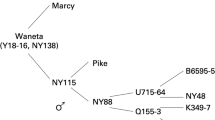Abstract
Sentinel (FV8957-10) is a new yellow-fleshed potato cultivar that produces a high yield of attractive round to oval tubers at early harvest. Sentinel is suitable for fresh market use and chip processing. It was selected at the Lethbridge Research Centre of Agriculture and Agri-Food Canada, AB from a cross made at the Potato Research Centre of Agriculture and Agri-Food Canada, NB between breeding clones F72218 and F47024. Sentinel has erect medium-height vines and produces uniform tubers of medium-size with a light buff skin, light yellow flesh and shallow eyes. In multi-date-harvest trials, Sentinel produced similar or higher marketable yield compared to Atlantic and NorValley in southern Alberta. When harvested at 80 days after planting, Sentinel produced similar or greater yield than Superior and Conestoga at test sites across western Canada. Specific gravity of Sentinel was less than Atlantic and Conestoga but higher than NorValley and Superior, whereas chip colour was similar to Atlantic and lighter than NorValley or Superior. Sentinel showed little tendency to slough or to darken after cooking. It showed clear foliar and tuber symptoms when infected with bacterial ring rot. Sentinel is moderately susceptible to verticillium wilt, early blight, fusarium wilt and common scab and susceptible to late blight.
Resumen
Sentinel (FV8957-10) es una nueva variedad de papa de pulpa amarilla que produce alto rendimiento de tubérculos ovales atractivos en cosecha temprana. Sentinel es deseable para uso en mercado fresco y para proceso de frituras. Se seleccionó en el Centro de Investigación Agrícola Lethbridge de Agri-Food Canadá, AB, de una cruza hecha en el Centro de Investigación de Papa y Agricultura de Agri-food Canadá, NB, entre los clones de mejoramiento F72218 y F47024. Sentinel tiene follaje erecto de media altura y produce tubérculos uniformes de tamaño medio, con una piel marrón claro, pulpa amarilla clara y ojos superficiales. En las cosechas de ensayos multi fechas, Sentinel produjo rendimiento similar o más alto comercial comparada a Atlantic y NorValley en el sur de Alberta. Cuando se cosechó a los 80 días después de la siembra, Sentinel produjo rendimiento similar o mayor que Superior y Conestoga en lugares de prueba por todo el oeste de Canadá. La gravedad específica de Sentinel fue menor que Atlantic y Conestoga, pero más alta que NorValley y Superior, mientras que el color de la hojuela fue similar al de Atlantic y más claro que el de NorValley o Superior. Sentinel mostró ligera tendencia a desprendimiento de la piel o a oscurecimiento después de cocinada. Mostró síntomas claros en follaje y tubérculos cuando se infectó con la pudrición anular bacteriana. Sentinel es moderadamente susceptible al marchitamiento por Verticillium, tizón temprano, marchitez por Fusarium y la roña común, y susceptible al tizón tardío.


Similar content being viewed by others
References
Bizimungu, B., D.R. Lynch, L.M. Kawchuk, Q. Chen, M. Konschuh, C. Schaupmeyer, J. Wahab, D. Waterer, D. Driedger, H. Wolfe, P. McAllister, R. Howard, and H.W. Platt. 2007. Northstar: a high-yielding, white cold-storage chipping potato cultivar with attractive oval tubers resistant to late blight. American Journal of Potato Research 84: 457–465.
Chen, Q., L.M. Kawchuk, D.R. Lynch, M.S. Goettel, and D.K. Fujimoto. 2003. Identification of late blight, Colorado potato beetle, and blackleg resistance in three Mexican and two South American wild 2× (1EBN) Solanum species. American Journal of Potato Research 80: 9–19.
Currie, V., and J.A. Sullivan. 2010. Ontario cooperative potato variety trials 2010. Guelph: University of Guelph.
Hellenäs, K.-E. 1986. A simplified procedure for quantification of potato glycoalkaloids in tuber extracts by h.p.l.c.; comparison with ELISA and a colorimetric method. Journal of the Science of Food and Agriculture 37: 776–782.
Holley, J.D., and L.M. Kawchuk. 1996. Distribution of thiabendazole and thiophanate-methyl resistant strains of Helminthosporium solani and Fusarium sambucinum in Alberta potato storages. Canadian Plant Disease Survey 76: 21–27.
Johnston, G.R., R.G. Rowberry, and J.F. Alex. 1983. Conestoga: a new early potato cultivar with very good table and chipping quality. American Potato Journal 60: 193–197.
Kawchuk, L.M., D.R. Lynch, G.C. Kozub, G.A. Nelson, F. Kulcsar, and D.K. Fujimoto. 1998. Multi-year evaluation of Clavibacter michiganensis subsp. sepedonicus disease symptoms in cultivated potato genotypes. American Journal of Potato Research 75: 235–243.
Love, S.L., J.J. Pavek, A. Thompson-Johns, and W. Bohl. 1998. Breeding progress for potato chip quality in North American cultivars. American Journal of Potato Research 75: 27–36.
Love, S.L., R. Novy, D.L. Corsini, and P. Bain. 2003. Variety selection and management, pp 21–47. In Potato production systems, eds. J.C. Stark & S. Love. University of Idaho Agricultural Communications, 426 p.
Lynch, D.R., S.J. Peloquin, L.M. Kawchuk, C.A. Scaupmeyer, J. Holley, D.K. Fujimoto, D. Driedger, D. Waterer, J. Wahab, and M.S. Goettel. 2001. AC glacier chip: a high-yielding chip cultivar for long-term storage. American Journal of Potato Research 78: 327–332.
Novy, R.G., G.A. Secor, B.L. Farnsworth, J.H. Lorenzen, E.T. Holm, D.A. Preston, N.C. Gudmestad, and J.R. Sowoldnos. 1998. NorValley: a white-skinned chipping cultivar with cold-sweetening resistance. American Journal of Potato Research 75: 101–110.
Rieman, G.H. 1962. Superior: a new white, medium-maturing, scab resistant potato variety with high chipping quality. American Potato Journal 39: 19–28.
Sowokinos, J.R. 2001. Biochemical and molecular control of cold-induced sweetening in potatoes. American Journal of Potato Research 78: 221–236.
Webb, R.E., D.R. Wilson, J.R. Shumaker, B. Graves, M.R. Henninger, J. Watts, J.A. Frank, and H.J. Murphy. 1978. Atlantic: a new potato variety with high solids, good processing quality, and resistance to pests. American Potato Journal 55: 142–145.
Acknowledgments
The following contributions are gratefully acknowledged: Mr. Erich Dyck (retired), Ms. Evelyn Lyon, Ms. Susan Smienk, Mr. Frank Kulcsar (retired), Mr. Henry Wolfe, Greg Larson and Mr. Ron Gregus for technical assistance. We also thank Dr. D. Lynch (retired) and Mr. C. Schaupmeyer (retired) for the information provided.
Author information
Authors and Affiliations
Corresponding author
Rights and permissions
About this article
Cite this article
Bizimungu, B., Kawchuk, L.M., Wahab, J. et al. Sentinel: An Early Yellow-Fleshed Potato Cultivar Suitable for Fresh Market and Chip Processing. Am. J. Potato Res. 90, 331–339 (2013). https://doi.org/10.1007/s12230-013-9309-0
Published:
Issue Date:
DOI: https://doi.org/10.1007/s12230-013-9309-0




